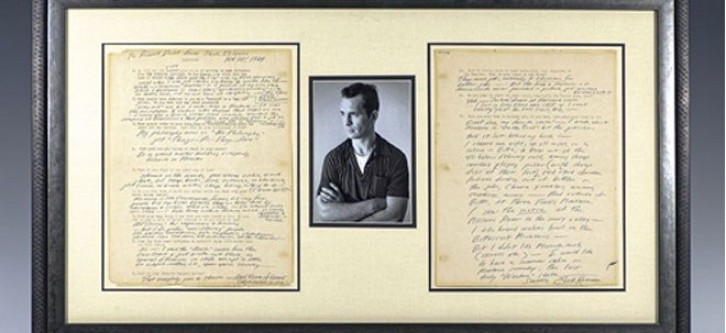Every so often an ABAA member lists an item that gets people in the business talking, regardless of whether it fits with their own particular interests or specialities. One of those items is this exceptional letter from Jack Kerouac to a young boy tasked with writing to a published author for a school project. The response is generous, eloquent, and expansive, offering more of a window into the author than the typical high-school project might reasonably be expected to produce!
Jack Kerouac Autographed Manuscript
by Jack Kerouac
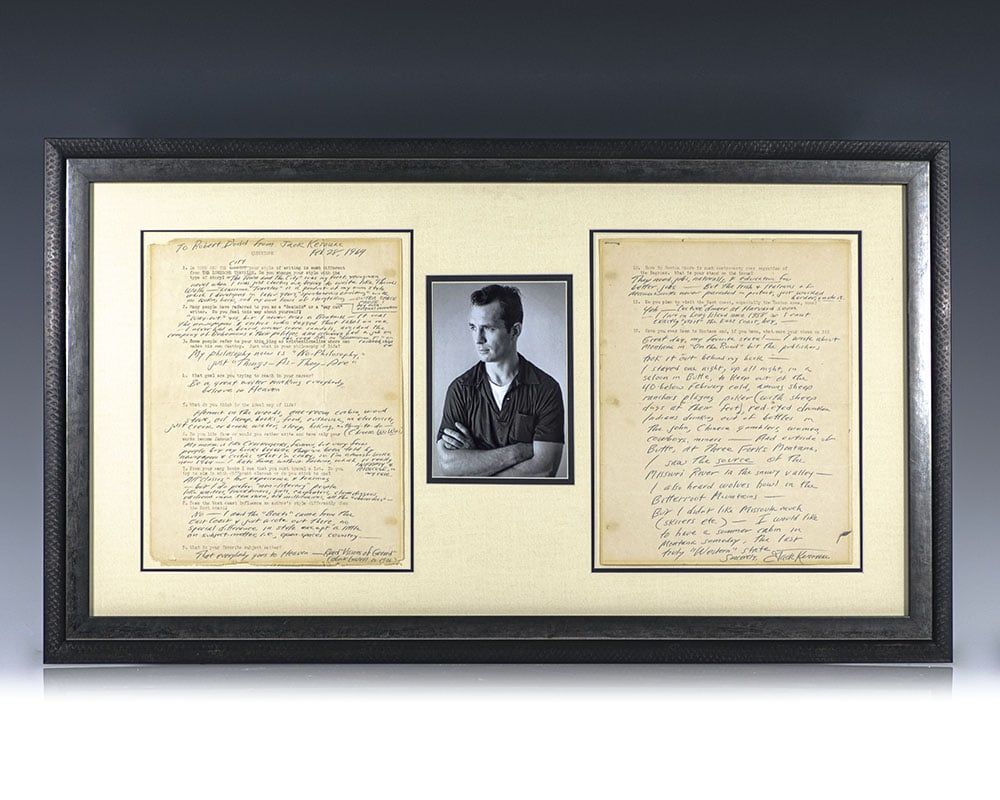
Description:
1964. Jack Kerouac's candid handwritten reply to a young man's questions about being a "Beatnik," his life philosophy, his thoughts on Montana, and more. Students in Robert Dodd's ninth-grade class were given an assignment to contact their favorite writer with their own unique series of questions relating specifically to that writer. The young Dodd chose Jack Kerouac, and the author replied at length to his questionnaire, which includes queries about his classification as a "Beatnik" (his answer: "I never was a Beatnik - it was the newspapers and critics who tagged that label on me...."), life philosophy ("My philosophy is 'No Philosophy,' just 'Things-As-They-Are'"), career goals ("Be a great writer making everybody believe in Heaven"), the ideal way of life ("Hermit in the woods..."), his thoughts on fame ("My name is like Crackerjacks, famous, but very few people buy my books..."), and segregation ("[t]he Irish and Italians of Massachusetts never paraded in protest, just worked hard and made it").
Interestingly, Kerouac is most expansive in response to the final question: whether he has visited Montana. His answer fills three-quarters of the page, beginning: "Great day, my favorite state! - I wrote about Montana in 'On the Road' but the publishers took it out behind my back... I stayed one night, but up all night, in a saloon in Butte, to keep out of the 40-below February cold, among sheep ranchers playing poker." Two pages with Dodd's questions type-written and Kerouac's responses handwritten in full.
The letter reads in full, "To Robert Dodd from Jack Kerouac Feb. 28th 1964."
1. In Town and the Country (Kerouac crosses out Country for City) your style of writing is much different from The Lonesome Traveler. Do you change your style with the type of story? Kerouac responds: "'The Town and the City' was my first, youngman novel when I was just starting out, trying to write like Thomas Wolfe - 'Lonesome Traveler' is a product of my own style which I developed in later years, 'spontaneous writing' with no looking back, in my own laws of story telling - OUTERSPACE PROSE! My own original invention."
2. Many people have referred to you as a "beatnik" or a "way out" writer. Do you feel this way about yourself? "'Way-out' yes, but I never was a beatnik - it was the newspapers and critics who tagged that label on me - I never had a beard, never wore sandals, avoided the company of Bohemians and their politics and always had a job on the road like in 'Lonesome T.' on railroad, ships etc."
3. Some people refer to your thinking as existentialism where man makes his own destiny. Just what is your philosophy of life? "My philosophy now is "no-philosophy," just "Things - As - They - Are".
4. What goal are you trying to reach in your career? "Be a great writer making everybody believe in Heaven."
5. What do you think is the ideal way of life? "Hermit in the woods, one-room cabin, wood stove, oil lamp, books, food, outhouse, no electricity, just creek or brook water, sleep, hiking, nothing-to-do-(Chinese Wu Wei)."
6. Do you like fame or would you rather write and have only your works become famous? "My name is like Crackerjacks, famous, but very few people buy my books because they've been told by newspapers and critics that I'm crazy, so I'm almost broke now 1964 - I hate fame without fortune, which is really INFAMY AND RIDICULE, in my case."
7. From your many books I see that you must travel a lot. Do you try to mix in with different classes or do you stick to one? "All 'classes' for experience and learning - but I do prefer 'non-literary' people like waiters, truckdrivers, girls, carpenters, clam diggers, railroad men, sea men, old millionaires, all the 'characters'."
8. Does the West coast influence an author's style differently than the East coast? "No - I and the "Beats" came from the East Coast and just rode out there, no special difference in style except a little on subject matter, i.e. open-spaces country." 9. What is your favorite subject matter? "That everybody goes to Heaven - read "Visions of Gerard" (about Lowell in 1926)."
10. Here in Boston there is much controversy over segregation of the negroes. What is your stand on the issue? "They need jobs, naturally, and education for better jobs - But the Irish and Italians of Massachusetts never paraded in protest, just worked harder, and made it."
11. Do you plan to visit the East coast, especially the Boston area soon? "Yeh - "lecture" dinner at Harvard soon - I live in Long Island since 1958 so I can't exactly "visit" the Ease Coast, hey," -
12. Have you ever been to Montana and, if you have, what were your views on it? "Great day, my favorite state! - I wrote about Montana in "On the Road" but the publishers took it out behind my back - I stayed one night, up all night, in a saloon in Butte, to keep out of the 40- below February cold, among sheep ranchers playing poker (with sheep dogs at their feet), red-eyed drunken Indians drinking out of bottles in the john, Chinese gamblers, women, cowboys, miners - And outside of Butte, at Three Forks Montana, I saw the source of the Missouri River in the snowy valley - I also heard wolves howl in the Bitterroot Mountains - But I didn't like Missoula much (skiers etc.) - I would like to have a summer cabin in Montana some day, the last truly "Western" state.
Sincerely, Jack Kerouac."
In near fine condition. Matted and framed. The entire piece measures 31 inches by 18 inches.
A rare and intimate glimpse into the thought an literary progression of one of the formative writers of the 20th century. Born in Lowell, Massachusetts, literary iconoclast Jack Kerouac is generally considered the father of the Beat movement, although he actively disliked such labels. Kerouac's method was heavily influenced by the prolific explosion of jazz in 1960s America and later by his studies in Buddhism that originated with fellow beat and academic Gary Snyder. The raucous, exuberant, often wildly funny account of a journey through America and Mexico, Jack Kerouac's On the Road instantly defined a generation on its publication in 1957: it was, in the words of a New York Times reviewer, "the clearest and most important utterance yet made by the generation Kerouac himself named years ago as 'beat.'"
Written in the mode of ecstatic improvisation that Allen Ginsberg described as "spontaneous bop prosody," the novel remains electrifying in its thirst for experience and its defiant rebuke of American conformity. In his portrayal of the fervent relationship between the writer Sal Paradise and his outrageous, exasperating, and inimitable friend Dean Moriarty, Kerouac created one of the great friendships in American literature; and his rendering of the cities and highways and wildernesses that his characters restlessly explore are a hallucinatory travelogue of a nation he both mourns and celebrates.
--Offered by former ABAA-member Raptis Rare Books. [This item is no longer available]
But, this isn't the only remarkable piece of Kerouaciana offered by our members. Earlier this year, ABAA-member University Archives sold Kerouac's personal first-edition copy of On the Road, and ABAA-member Charles Agvent recently published a catalog of books and ephemera from the library of beat icon Herbert Huncke, including several items signed by or related to Kerouac. (University Archives recently posted an interesting interview with John Shen-Sampas, literary executor of the Jack Kerouac estate, on their blog...)
Below you'll find a selection of other books and letters by Jack Kerouac currently offered by ABAA members, as well as some noteworthy items by other members of the beat generation:
ON THE ROAD (SIGNED, FIRST EDITION)
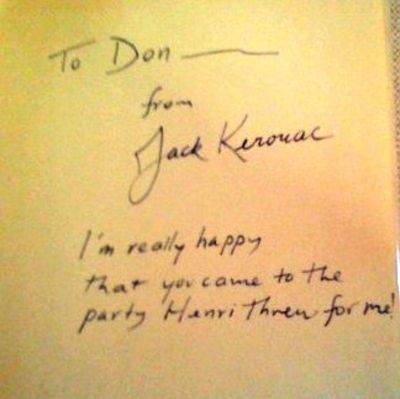
New York: The Viking Press, 1957. First Edition. Hardcover. Both the book and the dustwrapper are bright and fresh, with a few very short closed tears to the top of the dustwrapper. Fine in a Near Fine dustwrapper. Third Printing in a Third Printing dustwrapper BUT INSCRIBED and SIGNED by the author on the front endpaper: "To Don---/from/Jack Kerouac/I'm really happy/that you came to the/party Henri threw for me!" Henri was one of Kerouac's oldest friends, Henri Cru, the character Remi Boncoeur in ON THE ROAD. (Some years ago we sold a copy of this book inscribed to Henri as "my best friend" by Kerouac.). Except for one book signing event in Denver for his first book, THE TOWN AND THE CITY, Kerouac did not do promotional signings for any of his books. When ON THE ROAD was published, Kerouac was so overwhelmed by the publicity that he went into self-imposed exile with his mother. Consequently, inscribed copies of any printing of this, his most important book, are rare. The heavyweight champ of Beat Literature finally made into a film after years of speculation. While Kerouac was alive he wanted to play Sal Paradise and costar with Marlon Brando, but Brando decided against the project.
Offered by Charles Agvent.
The Subterraneans (Inscribed)
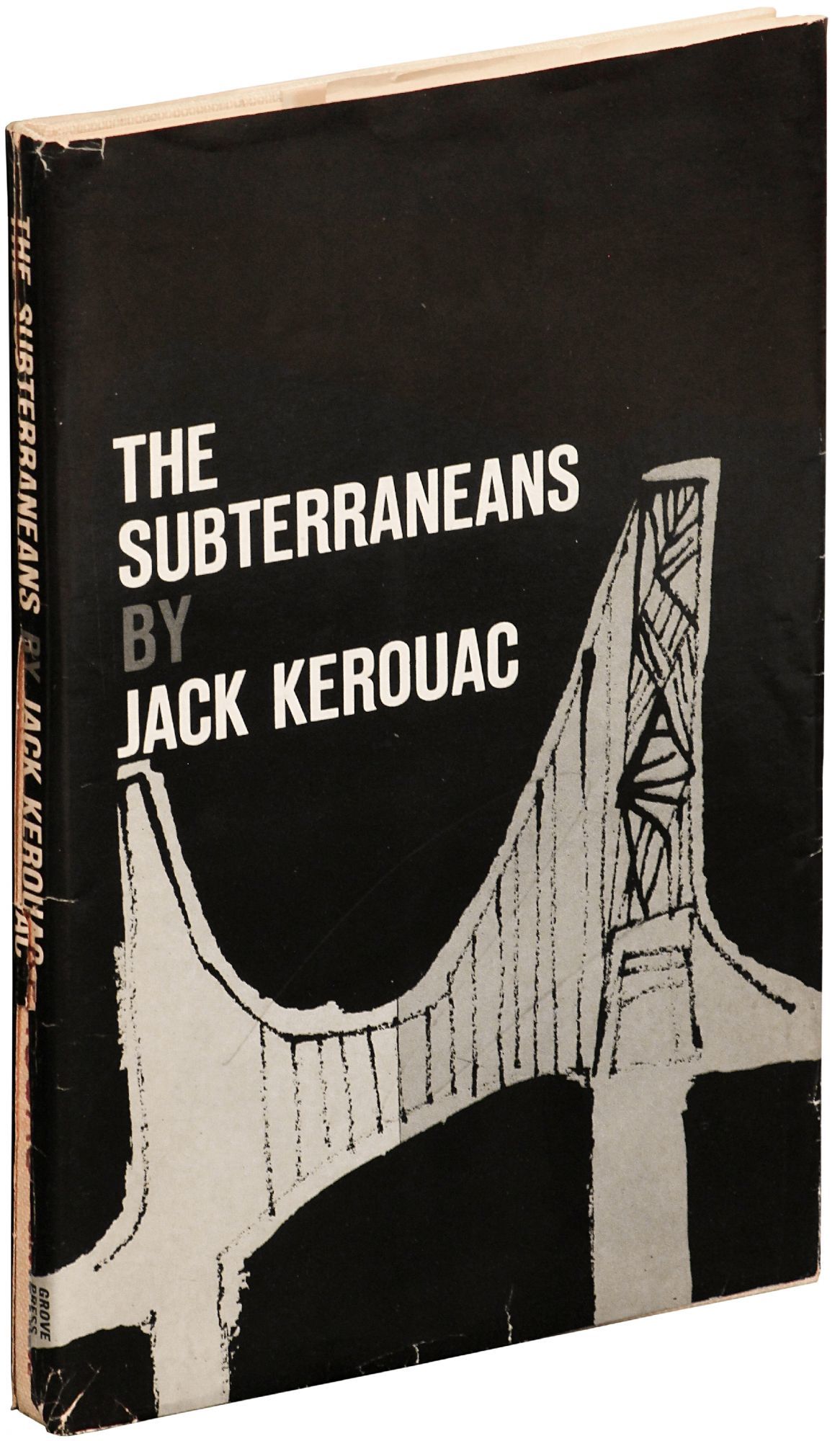
New York: Grove Press, 1958. Hardcover. Very Good/Very Good. Second printing. Professionally recased. Good with the pages somewhat toned and the first few dampstained but fresh lettering on the front board and spine fresh in good dustwrapper a bit rubbed, a few tiny tears and partially split at the spine. Inscribed by Kerouac to Terry Southern: "To Beautiful Terry from Ugly Uncle Jack, Jack." Kerouac and Southern met through Mason Hoffenberg, Southern's *Candy* co-author, when Southern returned from Paris to New York and settled in Greenwich Village. Southern was notorious for abusing his books and this copy is no exception, hence the re-casing. Still a spectacular association copy linking two iconic counterculture figures in what is often considered one of the scarcest of Kerouac's books to find signed.
Offered by Between the Covers Rare Books.
Someday you'll be lying... (Broadside Poem)
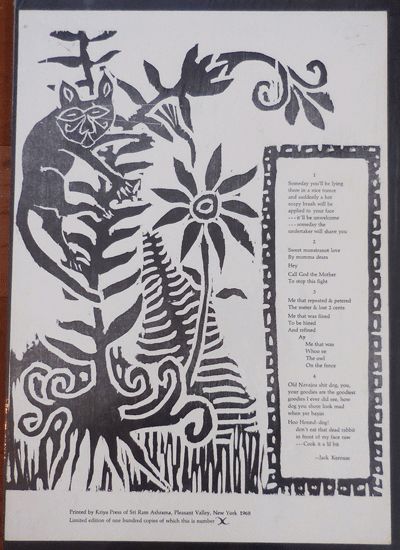
Pleasant Valley, NY: Kriya Press, 1968. First edition. Paperback. Fine. Single sheet illustrated broadside with four short poems by Kerouac. Fine condition. Measures 12 x 17". Per the colophon "Limited edition of one hundred copies of which this is number X" (Perhaps denoting #10?) Charters makes no mention of a lettered edition. In any event, a scarce piece of beat culture ephemera.
Offered by Derringer Books.
The Subterraneans (Original three-sheet poster for the 1960 film)
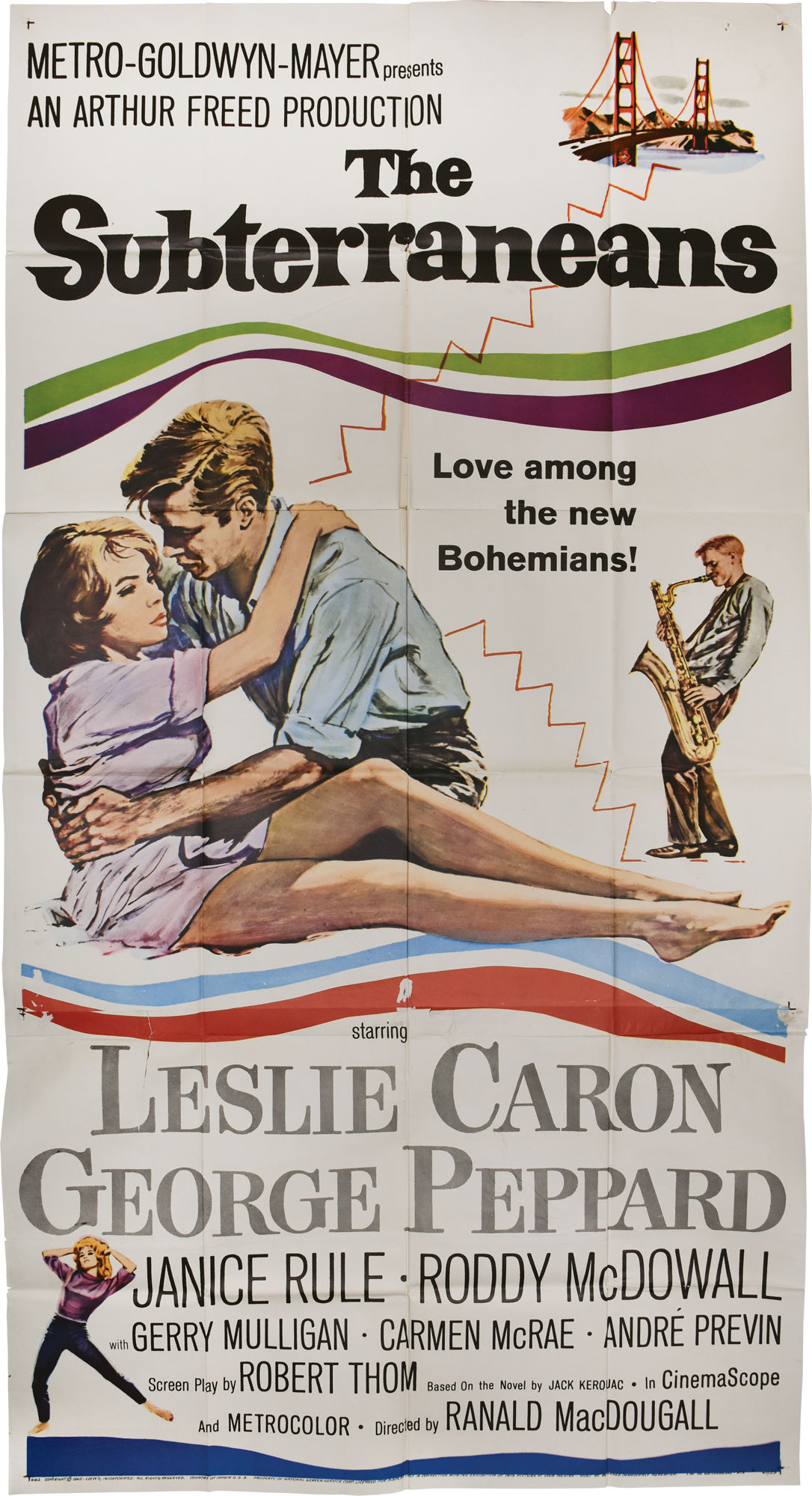
Beverly Hills, CA: Metro-Goldwyn-Mayer [MGM], 1960. Original three sheet poster for the 1960 film. From one perspective, a fairly one-dimensional representation-perhaps even a caricature-of Beat culture, but culturally fascinating in that it was made at the height of the Beat era, with A-list talent by a top studio, and, until Walter Salles' 2012 adaptation of "On the Road," was the only feature-length film ever made from a Kerouac novel. Kerouac was paid $15,000 by MGM for the rights to the book, and bought his first home with the proceeds, on Long Island. A film that rarely screened today, and has never been available on any kind of home viewing format. While its perspective on the actual Beat scene may be skewed or wildly misinterpreted, it is nonetheless important as an interpretation of Kerouac's world from the outside looking in. 41 x 81 inches, folded as issued. Very Good, with minor wear at the folds.
Offered by Royal Books.
Desolation Angels (First Edition)
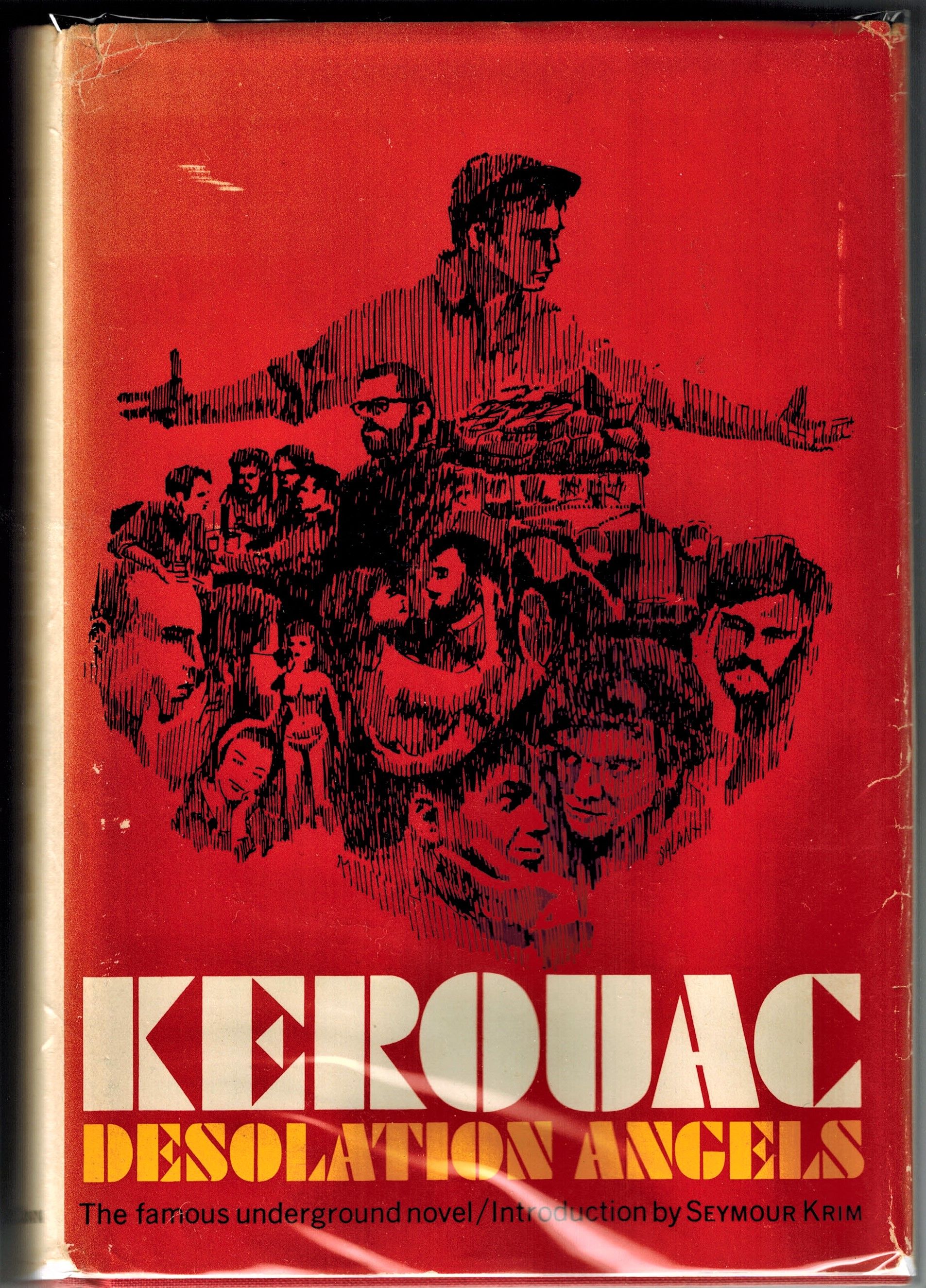
New York: Coward, McCann, 1965. Introduction by Seymour Krim. SCARCE in collectible condition. Near Fine, a bit of separation of page block at head of spine, in a Very Good dust jacket, spine sunned yet still legible, 1/2" closed tear bottom edge rear panel, small chips at folds. . First Edition. Cloth. Near Fine/Very Good. 8vo - over 7¾" - 9¾" tall.
Offered by Dale Steffey Books.
Typed letter signed ("Jack") in pencil, to Ian Macdonald
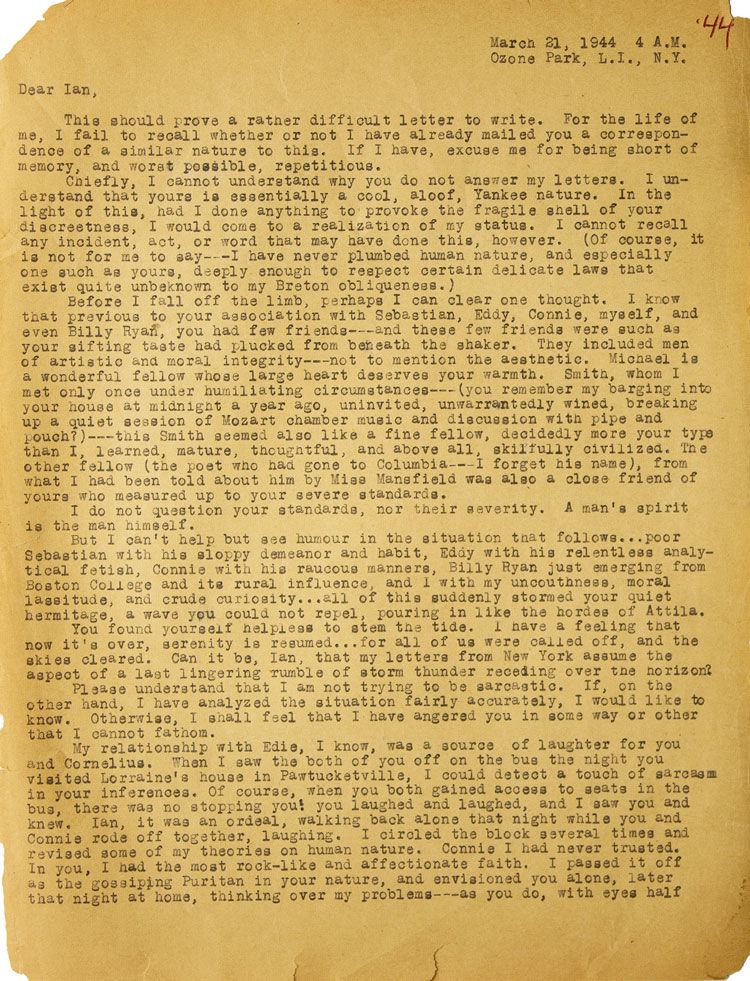
Ozone Park, Long Island, New York, 1944. 2 pp. Annotated "'44" in red ink in upper right corner. 4to. Toned, tiny chips at corners, brittle at edges, old tape reinforcement to margins on verso. 2 pp. Annotated "'44" in red ink in upper right corner. 4to. "You were the only true teacher I ever had, my friend." ...
Unpublished Kerouac letter. A poignant, emotionally vulnerable letter written by a 22-year-old Kerouac to Ian Macdonald, one of his close friends from his hometown of Lowell, Massachusetts, interrogating Macdonald on the cooling of their friendship; discussing his future first wife, Edie Parker; and mentioning several works in progress, including the earliest version of his first novel, The Town and the City, Visions of Gerard, and others. Kerouac and Macdonald had been part of a tight-knit group of aspiring writers and artists in Lowell in which the young Kerouac found intimate friendship and intellectual and artistic nourishment in the early years of his development. At the time of this letter, Kerouac had been living in New York for four plus years.
"This should prove a rather difficult letter to write," Kerouac begins, adding: "I cannot understand why you do not answer my letters." In speculating whether he'd done something to offend Macdonald, Kerouac mentions their old Lowell crew ("Sebastian, Eddy, Connie, Billy Ryan"), alludes to an episode when he crashed a party at Macdonald's place ("you remember my barging into your house at midnight a year ago, uninvited, unwarrantedly wined, breaking up a quiet session of Mozart chamber music and discussion with pipe and pouch?"), and recalls the hurt he'd recently felt after discovering that his "relationship with Edie ... was a source of laughter for you and Cornelilus ... it was an ordeal, walking back alone that night while you and Connie rode off together, laughing. I circled the block several times and revised some of my theories on human nature." (He adds that his "plans for the next six months do not include [Edie], much to her anger" though in fact they would be married four months later.)
Turning to his literary output, Kerouac writes, "My original idea was to tell you of my latest work, over which I am overly excited---about the novel, 'Galloway' [i.e. The Town and the City], which is at the 30,000-word mark; about my long poem in four parts, entitled 'Supreme Reality'; and about a work I began quite recently, 'Dear Brother', which is destined to become a 150,000-world letter to "my brother, whom I have created in the image of my spirit.'" (This would be the first efforts toward what would ultimately become Visions of Gerard.) He ends by imploring Macdonald to resume writing to him, invoking the extraordinary impact their friendship has had on his life: "Most important in my mind, Ian, is to find out what's wrong ... I haven't one friend in the world who is a fellow artist and to whom I can express myself. The generous time you devoted to me, during those days when we used to play Beethoven and admire each other's works and devour sumptuous feasts, was a time that I shall never forget. You were the only true teacher I ever had, my friend." He ends by saying that his "offer to come to New York still stands, and imploring, "Try to come, Ian. And please write. I'm afraid I am now ready to collapse into my bed. I have been writing all night.
Offered by James Cummins, Bookseller.
Early Photographs from the Collection of William S. Burroughs
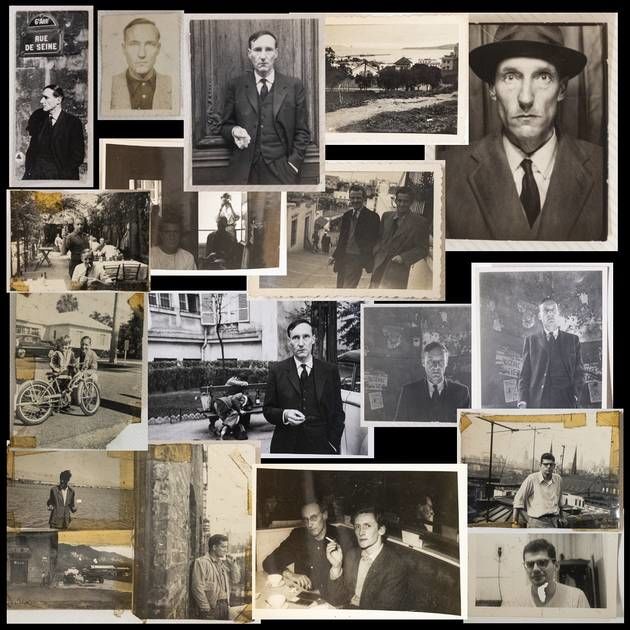
[ca 1950s]. An album containing early photographs by and of William S. Burroughs and other figures of the Beat generation, including photo collages and partial collages, with annotations by Burroughs; a photobooth portrait; a passport photo; a negative of an unpublished Brion Gysin photograph of Burroughs from 1959 (with contemporary archival print); and other images. 32 photographs in all, plus calling cards of Bruno Heinrich and Charles Henri Ford, and a copy of Driffs magazine -- "The Antiquarian and Second Hand Book Fortnightly" -- which includes Part 1 of Iain Sinclair's "Definitive Catalogue" of the Beats -- this part being devoted entirely to the works of William Burroughs, with this album as item number 80 in the catalogue.
The photographs are primarily from the early 1950s -- the ones annotated by Burroughs having dates from 1952 to 1954. Several photographs are taped together, forming early visual collages, while a number of the individual photos have sellotape along their edges, suggesting they were at one time part of a larger collage. The collages, or collage fragments, represent some of Burroughs' earliest attempts to use visual images in the way he was using words -- to transcend time and space, and link together various aspects of his life and world, in ways that correlate to a "mindscape" -- akin to the connections between the stories he wrote during that period that were collectively known as the Interzone, which was also an early title for Naked Lunch. Brion Gysin, in his 1964 essay, 'Cut ups: A Project for Disastrous Success,' wrote that "Burroughs was more intent on Scotch-taping his photos together into one great continuum on the wall, where scenes faded and slipped into one another, than occupied with editing the monster manuscript" -- i.e., Naked Lunch, aka his Word Hoard. And Burroughs wrote in one of his Adding Machine essays: "I was back in my old garden room at the Villa Muniria [in Tangier], and it was here that I first started making photo-montages." This was March 1961.
The provenance of this group of materials is "the legendary Hardiment suitcase," belonging to poet Melville Hardiment, a friend of Burroughs during the years 1960-62, who is also known as the first person to have given Burroughs LSD, apparently without Burroughs' advance knowledge. Hardiment's wife at the time was Harriet Crowder, a photographer who is well-known for having taken the portrait of Burroughs on the LP "Call Me Burroughs." Hardiment bought a number of items from Burroughs in that time period and famously kept them in a suitcase. According to his second wife, Pat Hardiment, Melville would sell off the contents bit by bit, when he needed money. One group of materials ended up at the University of Kansas, and is known there as the Burroughs-Hardiment Collection: this group went from Hardiment to the bookseller Pat Zanelli, to bookseller Larry Wallrich, and then to the university. A second group of photographs and collages went into the collection of photographer Richard Lorenz, and were exhibited in the 1996 show at the Los Angeles County Museum of Art -- "Ports of Entry: William S. Burroughs and the Arts."
Offered by Ken Lopez, Bookseller.
Howl and Other Poems (SIGNED BY 5 OF THE BOOK'S PRINCIPAL FIGURES!!)
by ALLEN GINSBERG
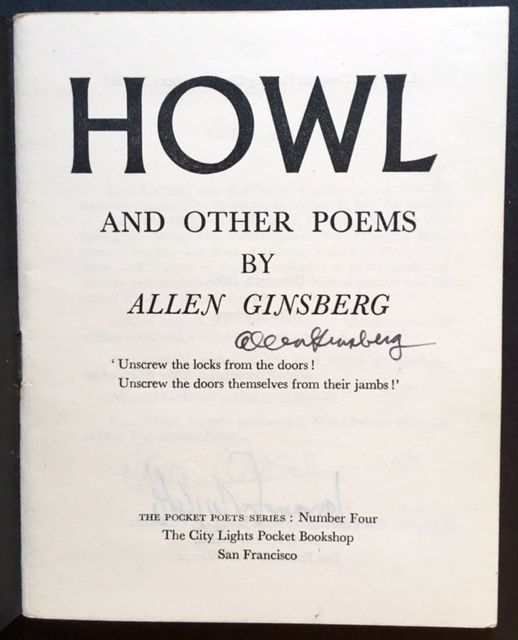
San Francisco: City Lights Pocket Bookshop, 1956. Original wraps. Near Fine. A remarkable Association copy of the 1956 correct 1st edition. This copy not only conforms to all the original issue points but is in beautiful, near-pristine condition. Furthermore, THIS COPY IS SIGNED BY 5 OF THE KEY FIGURES IN THE BOOK'S GENESIS: 1) ALLEN GINSBERG (on the title page); 2) LAWRENCE FERLINGHETTI (on the copyright page); 3) LUCIEN CARR (on the dedication page); 4) WILLIAM BURROUGHS (also on the dedication page); and 5) CARL SOLOMON (on the first blank endpaper). In other words, this copy is signed by the book's author, its publisher and by 3 of its 5 dedicatees (only Jack Kerouac's and Neal Cassady's signatures are missing from this copy). Notably, of the 5 signatures, all critically important to the birth and evolution of "Howl", Lucien Carr's appears to be the most elusive. We know that Carr's relationship with the Beats grew tense early on and that he insisted his name be removed from all subsequent printings of "Howl". We also know that Carr himself introduced William Burroughs (an old friend from their St. Louis upbringing) to Jack Kerouac and Allen Ginsberg --and that Carr's infamous career at Columbia (as documented in the 2013 film "Kill Your Darlings") saw him as a very important muse to this budding literary scene. A fresh, tight copy, immaculate internally and easily Near Fine overall, while legitimately approaching Fine (even down to its unrusted staple). Also includes a hand-made chemise (signed by Ginsberg at a later date), a folded cardboard reproduction of the book's front cover which, among other things, capably protects the fragile 1st edition and no doubt helps to explain its remarkable condition. Of the 1,000 copies of "Howl" initially published, this must certainly rank as among the very most historic and significant.
Offered by Appledore Books.
On the Road (Original screenplay for the 2012 film)
by SALLES, WALTER (DIRECTOR); JACK KEROUAC (AUTHOR); JOSE RIVERA, HAROLD MANNING, MICHAEL HERR, FRANCIS FORD COPPOLA (SCREENWRITER); SAM RILEY,, GARRETT HEDLUND, KRISTEN STEWART, AMY ADAMS (STARRING)
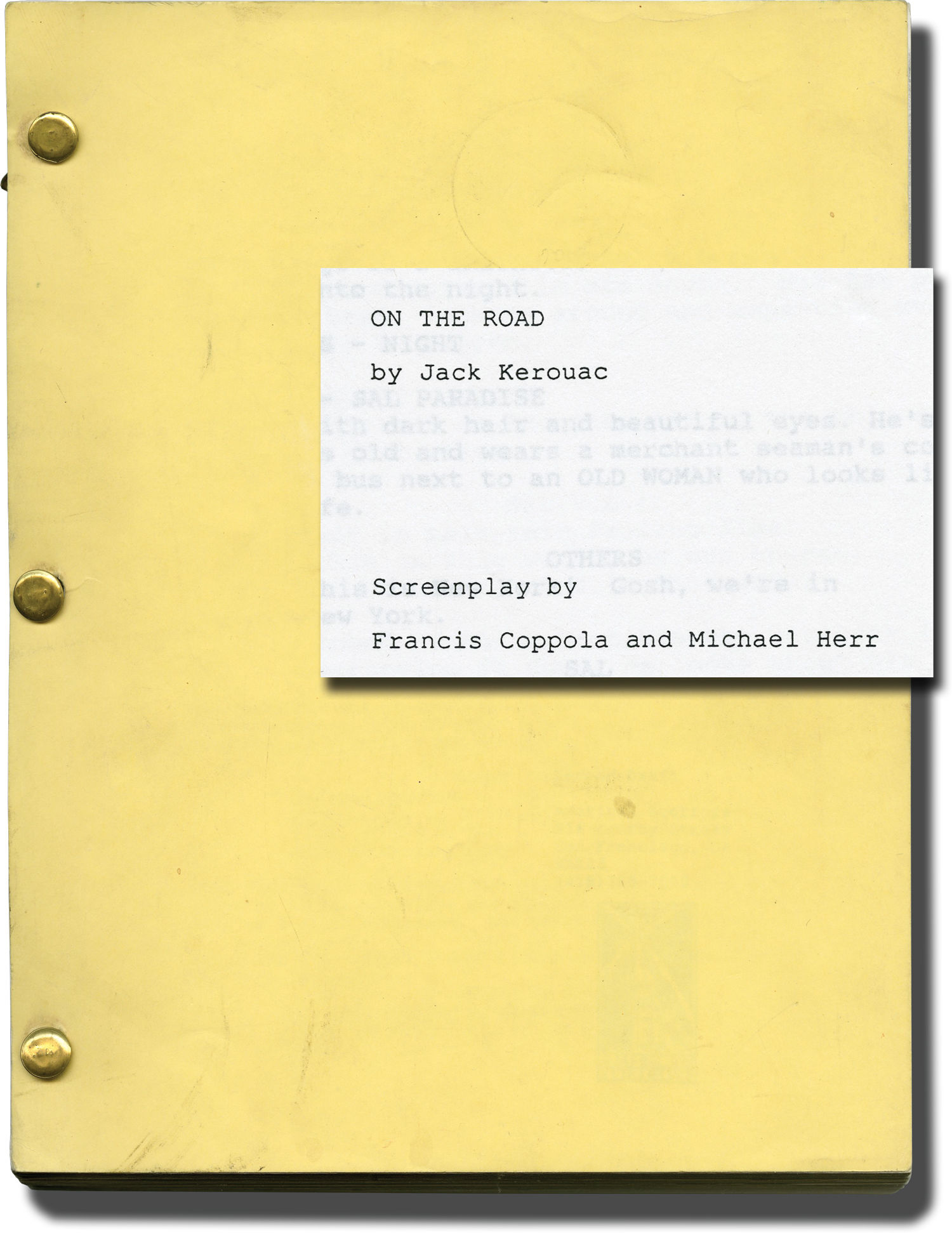
New York: IFC Films, 1980. Early unused Draft script for the 2012 film. Francis Ford Coppola bought the rights for Jack Kerouac's seminal, generation-defining novel in 1980 for $95,000. Coppola then struggled to find a screenwriter to adapt the book, as well as find a director. Eventually he settled on screenwriter Jose Rivera. Before that, however, he had drafts written under his direction from Michael Herr, Barry Gifford, Russell Banks, and even one himself with son Roman. This draft is one of the first attempts of Coppola to adapt the novel, which would not be made into a film until 2012, using Rivera's script, under the direction of Walter Salles and produced by Coppola. The film version was first proposed in 1957 by Kerouac himself, who wrote a one page appeal to actor Marlon Brando, asking Brando to play the part of Dean Moriarty, while Kerouac would play Sal Paradise. He never received a response from Brando. After his father is buried, Sal Paradise becomes acquainted with Dean Moriarty and along with his friend Carlo Marx, decides to experience America from behind the wheel of a car, rather than in the dusty classrooms of Columbia University. Set in America, shot on location in Canada, America and Mexico. Yellow untitled wrappers. Title page present, noted as Second Draft, with credits for screenwriters Francis Coppola, and Michael Herr. 176 leaves, with last page of text numbered 174. Xerographically duplicated. Pages Near Fine, wrapper Very Good plus bound with three gold brads.
Offered by Royal Books.


